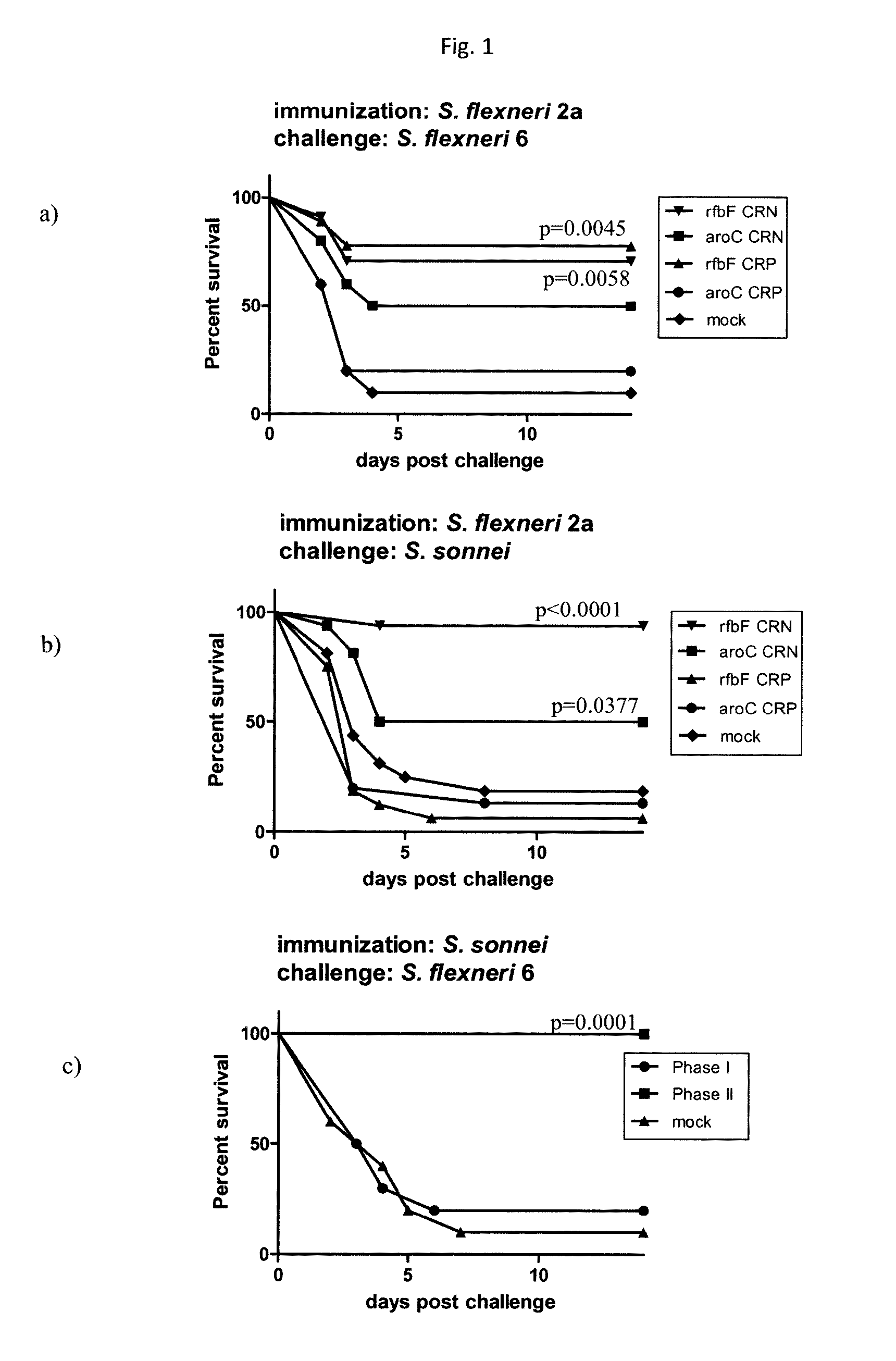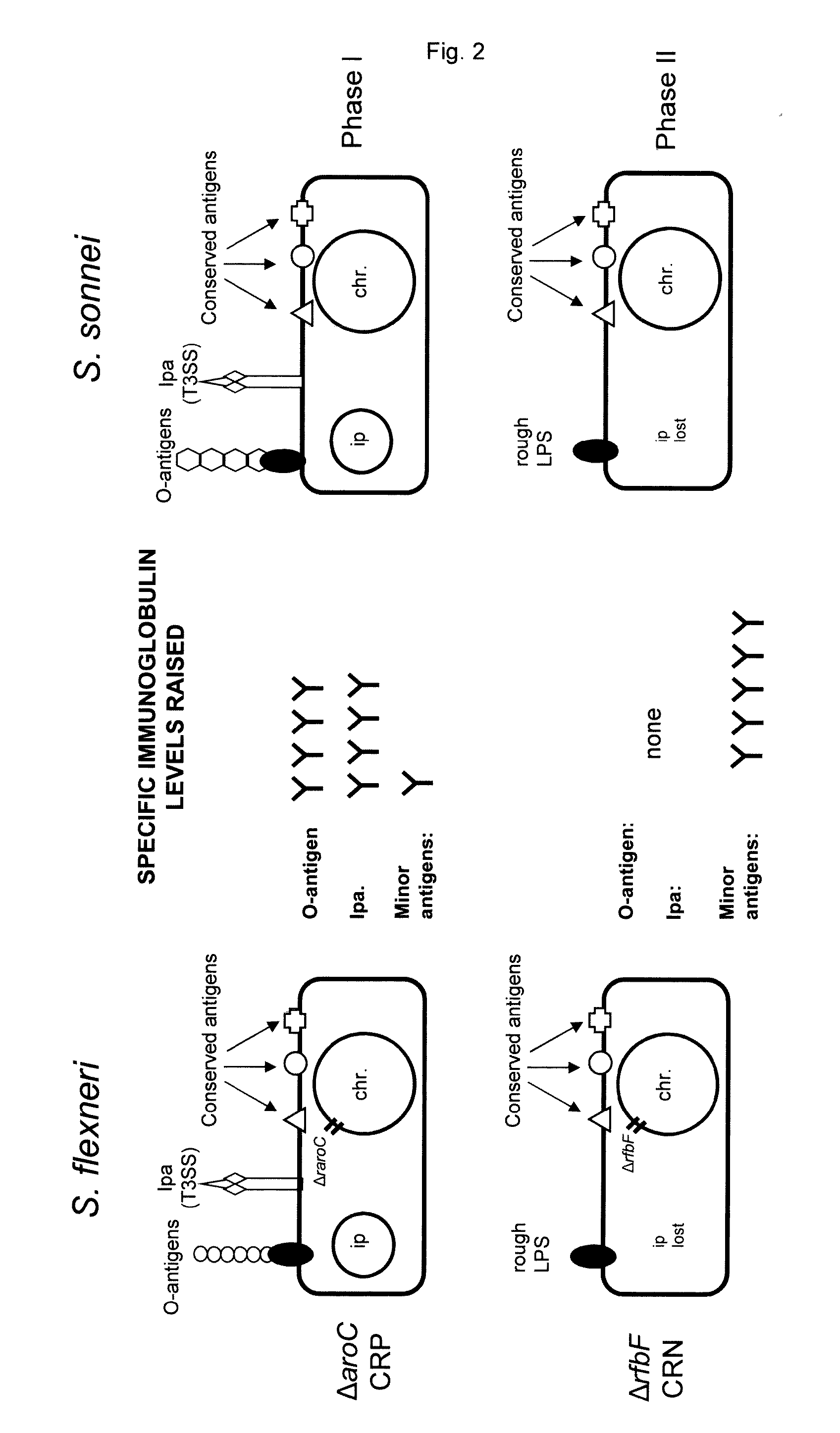Novel live attenuated shigella vaccine
a shigella and live technology, applied in the field of new live attenuated shigella vaccine, can solve the problems of affecting the development of shigella vaccines, affecting the safety of patients, and being too complex and hence expensiv
- Summary
- Abstract
- Description
- Claims
- Application Information
AI Technical Summary
Benefits of technology
Problems solved by technology
Method used
Image
Examples
example 1
Preparation of an Attenuated Shigella Strain
[0245]Methods
[0246]Bacterial Strains and Culture Conditions
[0247]Bacteria were routinely grown in Luria Bertani (LB) broth or agar plates. For the detection of an intact invasion plasmid expressing the ipa proteins tryptic soy agar (TSA) plates supplemented with 0.01% Congo Red dye (Sigma-Aldrich) were used. Fresh cultures were always started from a Congo Red-positive (CRP) colony ensuring plasmid carriage. Where appropriate media were supplemented by the following concentration of antibiotics: ampicillin 100 μg / ml, kanamicin 100 ug / ml, chloramphenicol 25 μg / ml.
[0248]The sequenced prototype Shigella flexneri 2a strain 2 (strain 2457T, ATCC 700930) was used as a parental strain for mutagenesis. Inactivation of the aroC and rfbF genes was performed by the Red recombinase technique described earlier (Levine, M. M., et al. Nat. Rev. Microbiol. 5, 540-553 (2007)). Deletion of aroC results in an auxotrophic mutant unable to synthesize aromatic c...
example 2
Preparation of Shigella flexneri 2a 2457 Mutant with Synthetic Gene Construct on the Invasion Plasmid
[0260]The source material for mutant construction is the ATCC strain Shigella flexneri 2a 2457T as described above. Deletion of the rfbF and ipaB and ipaC genes as well as the ppa gene is performed using the Red recombinase technique (Datsenko, K. A. & Wanner, B. L. One-step inactivation of chromosomal genes in Escherichia coli K-12 using PCR products. Proc. Natl. Acad. Sci. U.S.A 97, 6640-6645 (2000)).
[0261]Step 1: the rfbF gene was removed from the chromosome. The lack of RfbF is associated with a phenotypic change: the Shigella strain becomes “rough”, a typical morphological change that can be detected by naked eye on agar plates. This phenotypic change was observed, but the successful removal of the rfbF gene was also confirmed by PCR analysis. It was based on the different length of the PCR product obtained with genomic DNA from wild type or mutated Shigella (FIG. 8).
[0262]Step ...
example 3
Animal Protection Studies to Test the Mutant Strain of Example 2
[0265]Virulence attenuation of the isogenic mutant strains vs. their parental wild-type strain was shown in the mouse lung model of shigellosis. Groups of mice were infected intranasally with 10-fold serial dilutions (between 106 and 108 cfu) of the different bacterial strains in order to determine the minimal lethal dose for each strains. In case of the wild-type strain, there was a 30, 50, and 100% lethality found at 106, 107, and 108 cfu / mouse doses, respectively. In contrast, no mice died from any of the isogenic mutants 2457TΔrfb, 2457TΔipaBC, or double mutant 2457TΔrfbΔipaBC at any of the tested doses. These results suggest high virulence attenuation in all mutants upon deletion of the corresponding genes.
[0266]Subsequently, groups of mice were immunized in the same model with sublethal doses of either wild-type strain 2457T (5×106 cfu / mouse) or its isogenic deletion mutants 2457TΔrfb, 2457TΔipaBC, 2457TΔrfbΔipaBC...
PUM
| Property | Measurement | Unit |
|---|---|---|
| Fraction | aaaaa | aaaaa |
| Strain point | aaaaa | aaaaa |
Abstract
Description
Claims
Application Information
 Login to View More
Login to View More - R&D
- Intellectual Property
- Life Sciences
- Materials
- Tech Scout
- Unparalleled Data Quality
- Higher Quality Content
- 60% Fewer Hallucinations
Browse by: Latest US Patents, China's latest patents, Technical Efficacy Thesaurus, Application Domain, Technology Topic, Popular Technical Reports.
© 2025 PatSnap. All rights reserved.Legal|Privacy policy|Modern Slavery Act Transparency Statement|Sitemap|About US| Contact US: help@patsnap.com



